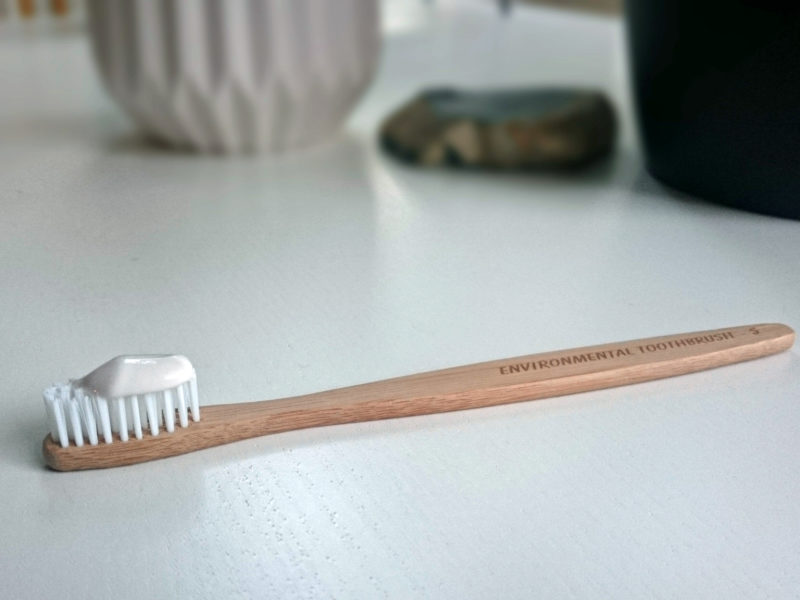
The things we’re least likely to question are those that we don’t even consciously recognize as being optional or changeable. Learned behaviors, we could call them. Our relationship with toothpaste is one of those very things. We need it to maintain a gleaming smile, but how many of us actually look at the ingredients label and question what’s gone into our trusty tube? I did that very thing and was horrified. I figured, surely some of these ingredients can’t be legal? But they are.
I then started looking for alternatives to mainstream versions that still did the job but without so many of the additives I deemed unnecessary. The result is that after a year of using alternatives to mainstream toothpaste, a recent dentist appointment confirmed that my teeth healthier than ever. I now have full confidence in sharing my thoughts and advice on healthy toothpaste.
It wasn’t until I reached my twenties that I started looking seriously into my cosmetics and thinking about the ingredients I was putting onto my body (or into my mouth as the case is with toothpaste). It took a lot of research to understand all those long names and find out what those ingredients really did. I was interested in where they came from and what the effects were on my body.
The American Dental Association describes toothpastes as substances that “help to remove plaque, a film of bacteria that form on teeth and gums.” Ingredients vary from one formula to the next, but there’s a general composition that we see across the board.
First up is fluoride. This is added to prevent tooth decay and strengthen our enamel. Fluoride is probably the most talked about, controversial ingredient in toothpaste. It is also found in our water supply. But why the controversy?
I feel like fluoride falls into the same category as parabens. Some people are extremely passionate about keeping far away these substances. Others have not found significant evidence to show parabens to be detrimental to them. It’s important to also remember that we encounter so many potential toxins in our daily lives that you simply can’t avoid them all. You have to choose your battles.
In case you’re interested, some studies have shown fluoride to deplete bone quality. Fluorosis appears to be the greatest concern with bio-accumulated fluoride in the body: a disease which affects the appearance of teeth. Teeth can develop white streaks or be stained yellow-brown from the over-ingestion of fluoride. This can result from swallowing toothpaste–a problem sometimes seen in children who enjoy the taste. There is also this risk from drinking water supplies with a higher-dose of fluoride. This, of course, varies from place to place.
In theory, the above can be avoided and you can still use your regular fluoride toothpaste for its positive effect in preventing tooth decay. The first is ensuring that care is taken to prevent the toothpaste being swallowed–something that generally only affects the little ones. If you have a child, take some time to talk to them about the importance of making sure they don’t swallow the concoction during or after brushing.
Secondly, unlike your average Brita water filter, if you’re truly concerned about the fluoride levels in the water supply where you live, you can purchase a complex water purification system to remove it. These cost more, but if it’s something you can afford, it’s worth looking at.
Let’s move on to the other ingredients. I feel like fluoride gets all the limelight, but perhaps there are other concerns greater than this inorganic anion alone.
If you combine the artificial sweeteners like aspartame to make it taste nice, sodium lauryl sulfate (SLS) to create that familiar foam, and dehydrated silica gels or aluminum oxides to do the scrubbing, you’ve got a load of ingredients that arguably shouldn’t really be in places so close to the digestive tract. We know we shouldn’t swallow toothpaste, but does that mean that we don’t ingest a little bit each time we brush? No, of course not. We certainly do and bio-accumulation can keep these things lingering around in your tissue where you might not want them.
With all of the above, this fits into a wider picture of what you’re consuming each day at meal times and in your self-care regime. For example, you’re more at risk of aspartame causing side effects if you consume a lot of products with artificial sweetener in them, like soda. You’re more at risk of bio-accumulating aluminum salts if it’s also in your deodorant and other products. You get the picture.
So what can you do with all this information? It’s not about being terrified into making a different purchase next time your tube of toothpaste runs out. It’s about being aware of what you’re using. Be mindful of what you’re purchasing. This thinking should flow into all your consumables.
I personally opt for a tooth-cleaning combination that isn’t so mainstream. I am a fan of natural toothpastes and biodegradable bamboo toothbrushes. I’ve been partnering these for over a year now and my dentist gave me the nod of approval last week for a healthy smile, so I’m happy to promote them.
If you want to try an alternative to the popular and potentially detrimental brands, try looking for toothpastes that use brilliant naturally abrasive baking soda and flavors derived from herbs. You could also opt for fluoride-free if you decide it isn’t for you. Each brand and formula in the natural health community emphasize some ingredients as better than others. You’ll have to do your own research. I recommend at least trying the LUSH Toothy Tabs for a plastic-free product that is pretty fun to use and comes in a variety of flavors.

How do you keep your mouth healthy?
Also by Kat: Cotton: The Hard Truth about this Soft Fabric
Related: I Tried It: Turmeric Paste for Teeth Whitening
7 Ways to Get Whiter Teeth Naturally
Get more like this—Subscribe to our daily inspirational newsletter for exclusive content!
__
Photos: Sascha Lindner via Flickr, Kat Kennedy




